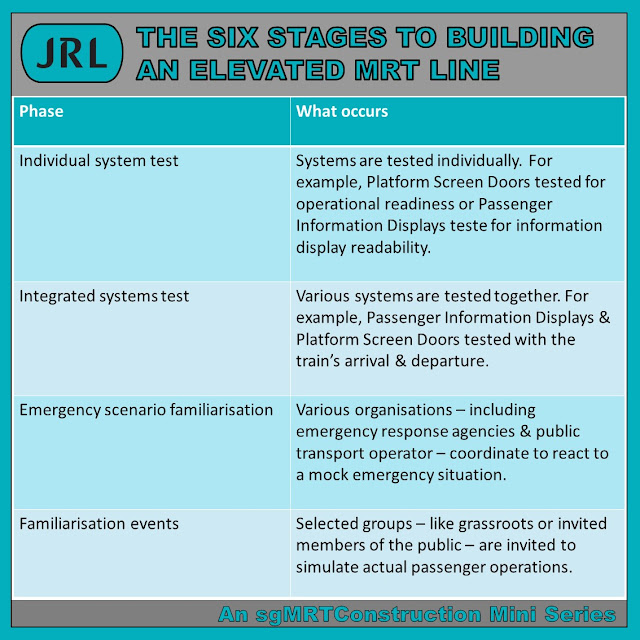We're now at the fifth stage out of six in constructing an elevated MRT line, which happens to be the testing & commissioning stage. In this stage, the aim is to ensure that all the systems required to operate an MRT line are fully functional and well integrated ahead of the line's operationalisation. This involves testing each component system individually, then together before undergoing certification ahead of the line's opening. Join us as we take a closer look at what works go on during this stage, a crucial one, before the line finally opens for revenue service.
Within this stage of works are several phases - the individual test phase, the integrated test phase, scenario testing phase & finally, familiarisation phase where passenger operations may be simulated. Each phase has different goals to accomplish and while typically conducted linearly, may at times be conducted in parallel.
Individual systems testing
Before the rail operations eco-system can exist, each component system has to be tested individually. This ensures that the systems are in working order and functional, before any form of integration with other systems can be performed. Some examples of individual systems testing would be the testing of Passenger Information Display systems - the LED display boards at station entrances and plasma TVs at the concourse levels or platforms. Trains need not necessarily be running in order for tests on these systems to be done. A functionality test of whether the system is capable of displaying the required information in the desired format can be conducted with dummy data to simulate an actual scenario of when the system is fully functional & integrated.
 |
| 24 January 2013 |
 |
| 1 August 2020 - LED board testing at Bright Hill station. |
Another example of a system that can be tested individually are the vertical and horizontal transport systems - fancy industry names for escalators, travellators and lifts. These systems can undergo tests individually at first but must eventually be linked up with other monitoring systems such as fire and emergency controls.
 |
| 28 December 2021 - A newly installed escalator at Outram Park North East Line (NEL) station undergoing tests. |
Integrated systems testing
Upon the completion of testing at an individual systems level, the next step is to work on integrating the various systems and then putting them through their paces to see how well they work together. Fine-tuning is necessary to allow for different systems to communicate with each other and speak the same language. Very similar to team building, it takes time for each component to gain familiarity with its team mates before functioning cohesively as a unit.
Emergency scenario familiarisation
Part of the commissioning works includes training for the staff & various support agencies. For instance, the public transport operator for the line performs drills with emergency response service teams from the Singapore Civil Defence Force and Singapore Police Force to tackle potential emergency scenarios that could one day call for a response. Coordination amongst the different entities is crucial to allow for evacuation or other responses to emergencies in a manner that ensures the safety of future passengers and emergency responders.
Each staff and emergency responder needs to know what to do in such a scenario. One sad and unfortunate example would be the incident involving maintenance crews that had accessed the live tracks at Pasir Ris station a few years back and were unable to avoid a train coming their way due to a lack of familiarity with the safety protocols
 |
| 16 September 2017 - An emergency evacuation exercise being conducted on the then soon to be opened DTL3 near Mattar station. |
Familiarisation events
Prior to the line's opening, there may be several familiarisation events conducted. These range from wayfinding feedback sessions, where participants visit the stations to provide feedback on the ease of navigation within, to open house events, where members of the public get to try out the line and familiarise themselves with the location of the new stations and facilities within. These events allow the Land Transport Authority (LTA) and public transport operator to receive feedback on things that can be improved ahead of the line's operation, allowing for final fine-tuning before revenue service commences.
One recent example was the reduction of train speed along the Thomson-East Coast Line (TEL) as a result of feedback from passengers that excessively loud sounds lead to an uncomfortable ride experience. Following the feedback, the trains slowed down at more problematic areas to reduce the squealing sounds produced to allow for a more comfortable ride for commuters.
 |
| 11 November 2022 - Passengers at the Stevens station TEL concourse during the TEL3 open house. |
 |
| 11 November 2022 - Passengers at Great World station during the TEL3 open house. |
 |
| 11 November 2022 - The Orchard TEL concourse during the TEL3 open house. |
 |
| 11 November 2022 - Commuters at the TEL Orchard station platforms during the TEL3 open house. |
With that, the line would likely be ready for the final stage in bringing an elevated MRT line to life. Do drop by our Facebook page to participate in the giveaway by answering the weekly quiz, liking & following the page. At this point, its an almost-guaranteed win! Prizes from Japan are up for grabs, so why not give it a go?








No comments:
Post a Comment